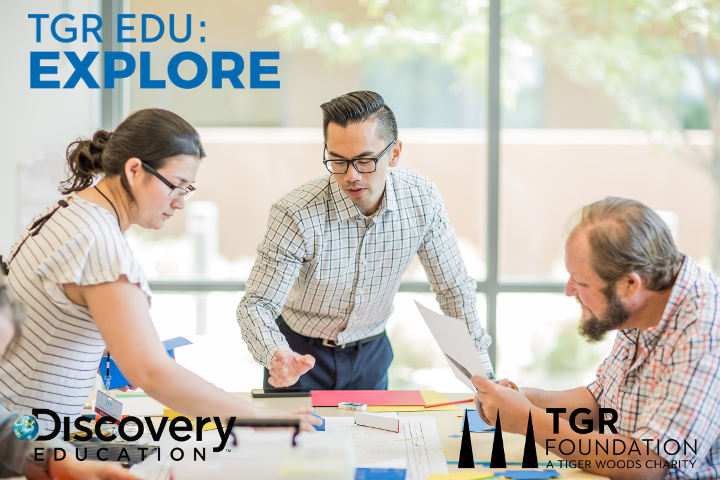Bringing Equity to STEM Education
By David Tong, Director, TGR EDU: Create

At TGR EDU: Explore, our mission is to empower educators, students and families to achieve their best in their academic and professional lives. This work includes helping every learner develop problem-solving and decision-making skills with real-world applications outside the classroom.
Progress for the STEM education movement must continue to improve, especially for students in underrepresented communities hard hit by COVID-19. We know that STEM-related education holds opportunities for students, but STEM learning must become more evenly distributed.
It’s imperative that we address barriers to STEM education now so that students won’t suffer later.
Here’s how TGR EDU: Explore is working to bring equity to STEM education.
Educator support
Educators, like their students, are constantly learning. If we want to support every student, we must first ensure that teachers are equipped to do so. We believe that every educator should have access to tools and support to grow – that’s why we’re committed to providing quality, no-cost professional development resources and support.
Engage in key topics, like STEM and interdisciplinary learning, with the all new professional development eLearning series delivering teaching strategies that focus on student-centered approaches to learning, with the goal of connecting all students – especially those from underrepresented populations – to success in school and beyond. Take your instruction to the next level in an hour or less with these resources:
- (Re)Defining STEM: Learn how to view STEM education with an updated lens, understand the principles for effective STEM teaching and learning, and come away with concrete strategies and activities that can transform student learning no matter the discipline.
- Interdisciplinary Learning - Making Connections: Discover teaching strategies that focus on interdisciplinary approaches to learning, with the goal of preparing students for success in the global workforce
Instructional strategies like differentiated instruction, interdisciplinary learning, and a focus on social and emotional learning are research-backed ways to help students grow.
Mix and match the resources or do them all together to build resilient and dynamic teaching strategies that empower all students towards success. By using these strategies in STEM instruction, we can avoid alienating students and instead, help them learn.
College and career preparation
It’s important that we are preparing every student for the future and helping them create a plan for college and/or career. It’s important to remember that some learners may be the first in their family to pursue college, which can feel daunting. Providing families with information about preparing for college, such as how to apply for scholarships and student aid, as well as details about the admissions process is a great way to get started.
We invite students to find their passion before deciding on a specific path. Activities like College Blueprint help students learn the basics of college access, exploration, the application process and paying for college at their own pace.
If we want to remove inequities in STEM, we must start with how we are helping students prepare for their futures. Through empathy, dedication and support, we can help more students pursue their dreams.
Accessible STEM lessons
For STEM education to be effective, it needs to be accessible. We can engage more students by including relatable activities both inside and outside of classrooms. I’m inspired by principal Marcia Reed, an advocate for accessible STEM, who explains:
“By exposing students to STEM and giving them opportunities to explore the field in a fun and engaging way, we help them achieve higher math and reading scores. But, there are benefits to being exposed to STEM in the classroom beyond test scores, such as improved problem-solving skills, creativity, mental alertness, and teamwork and collaboration. As leaders, we must ensure that every student has a chance to reap these benefits.”
TGR EDU: Explore provides several STEM activities that are rooted in real-life experiences. Here are a few examples for grades 6-8:
- Video Game Design: Challenge your students to learn video game design. From predicting viable industry career paths to taking the first steps in development and coding, students will learn how to make their video game come to life. This 4-day lesson plan introduces students to the fundamental principles of game design through a series of fun and interactive sessions.
- Robots to the Rescue: Through a guided interactive experience, students examine how robotic technologies help respond to natural hazards by aiding in a rescue and reconnaissance mission. During this guided exploration, students play the role of team members on the National Hazard Rapid Response Team, and are introduced to conditions and patterns of geologic forces that lead to natural disasters like volcanic eruptions, tsunamis, earthquakes, floods, hurricanes and more. Students will then be challenged to use block coding to program a rescue robot to aid in a rescue and reconnaissance mission.
- What’s lurking in your fast food?: Fast food has been associated with higher caloric intake and poorer diet quality in children and adolescents. Why is this? What is lurking in fast food that may contribute to this increase in childhood obesity? In this lesson students will synthesize information on the building blocks of life—carbohydrates, lipids and proteins— by conducting a series of chemical tests to determine which major biomolecules are found in common foods. After they have determined the nutrients that are in common foods, they will research and analyze the nutritional content of popular fast foods.
Use these and other digital resources to facilitate STEM learning. Whether instruction is taking place in the classroom or virtually, it’s important to have engaging STEM lessons ready-to-go.
In summary…
Take time to check in with students to see how they are feeling and ask how you may be able to offer additional support. Compile a list of free STEM resources. Encourage students to learn more about STEM and reinforce the idea that they can do it. During these challenging and unique times, let’s work together to bring equity to STEM education and close the gap.

